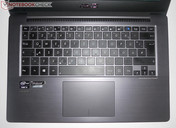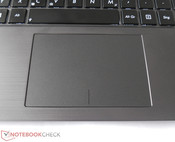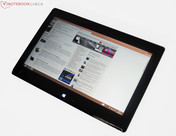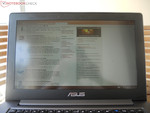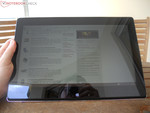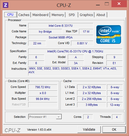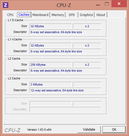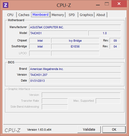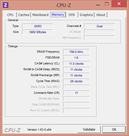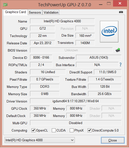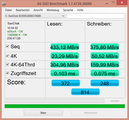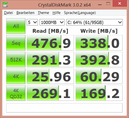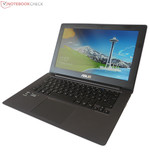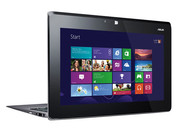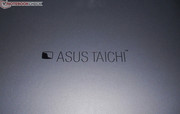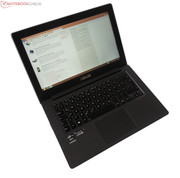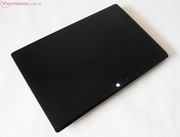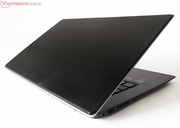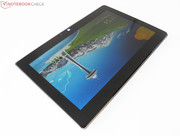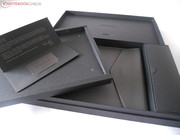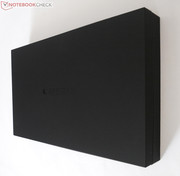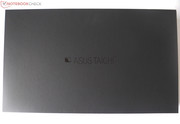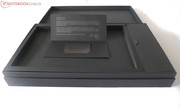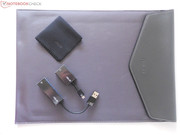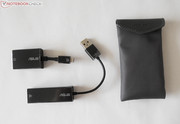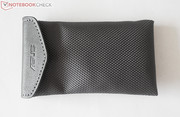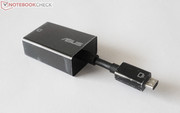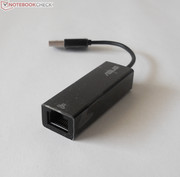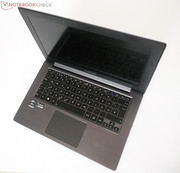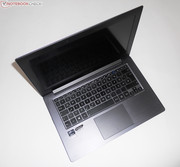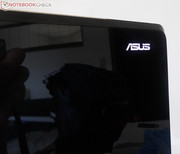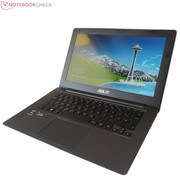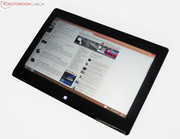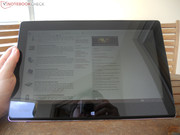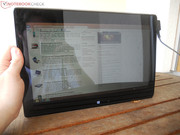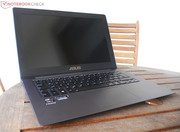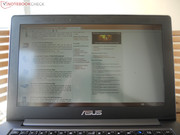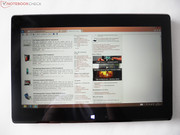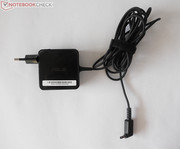Review Asus Taichi 31-CX003H Convertible Ultrabook
For the original German review, see here.
(April 11, 2014 Update: Users have been reporting driver issues relating to touchscreen functionality and other peculiarities after upgrading the Taichi 21 or Taichi 31 to Windows 8.1. Users may find the link here helpful if problems persist.)
Tablet or ultrabook? Many users face this question when focus is placed on a small, lightweight and slim portable computer. Asus wants to answer this question with its new Taichi 31-CX003H: two-in-one.
The manufacturer put on its thinking cap and designed a convertible device that combines the advantages of a laptop or ultrabook with those of a tablet PC. It features a Windows 8 operating system that is compatible with all common software programs paired with a touchscreen and the convenient one-hand operation of a tablet computer.
Is it the best of both worlds or just a poor compromise? As usual, we put the device through its paces and reveal what can be expected from the Asus Taichi 31-CX003H, which is the big brother of the previously tested Taichi 21.
Case
The Asus Taichi 31-CX003H's elegant casing is stylish and exceptionally slim at just 18 mm. That is certainly one of the convertible ultrabook's advantages and it looks like the premium Zenbook models, e.g. UX31A, in an opened state.
Like in the smaller, 11.6-inch Asus Taichi 21, Asus uses a robust yet elegant unibody casing comprised of dark, brushed aluminum for its 13.3-inch device. Not only the pleasant and high-quality feel and looks are excellent, but the very high stiffness and pressure resistance are equally outstanding. However, this compliment cannot be made to the same extent for the 8 mm display lid, which is due to the use of two screens. Light to medium force causes the display to warp visibly and thus does not completely confirm the device's premium claim in this point. The display hinge's smooth mechanism is pleasing and makes it possible to open the tablet-ultrabook with one hand. Then again, we would have appreciated a slightly tighter pulled hinge because the display lid, which almost seems too big for the device, is not always kept firmly in position on shaky surfaces.
Basically, the Taichi 31's elegant and stylish design, as well as the extremely robust though ultra-slim aluminum unibody casing convinced us. However, the display and hinge have to accept a bit of criticism for construction-related reasons.
Connectivity
As usual for ultrabooks, connectivity is not really the strength of slim, portable computers. The Taichi 31-CX003H is no exception but it partly compensates that with included dongles.
The slim, aluminum chassis of this convertible device sports 2 fast USB 3.0 ports, an SD card reader, an audio combo jack, a power socket and a micro-HDMI and mini-VGA for multi-monitor operation. Exemplary: Asus includes a mini-VGA to VGA dongle for the latter. However, we did not find a micro-HDMI to HDMI dongle. The omitted RJ 45 LAN port is compensated by a USB to LAN dongle. Basically a good idea but the user loses one of the only 2 USB ports. The rear and front do not sport any interfaces.
Communication
Connecting to the internet is accomplished via the built-in Wi-Fi adapter or, of course, the conventional LAN module. However, one of the two USB ports has to be sacrificed in order to use the LAN port dongle. The Wi-Fi module did not exhibit any connection problems during our tests. 5 out of 5 bars were displayed even at a distance of ~10 meters within range of sight as well as at a distance of approximately 7 meters through a wall. The signal first decreased to 4 out of 5 bars at a longer distance from 15 meters plus wall (D-Link DIR-615 Wireless N 300 router). Bluetooth is also available for wireless data sharing.
Accessories
To make it short: Exemplary! Besides the product's first-rate debut in an elegant black box, the accessories are also compelling. The equipment included for the Asus Taichi 31-CX003H is known from the Zenbook product line and encompasses a seemingly high-quality, artificial leather laptop sleeve for secure transportation and two dongles (USB to network-LAN, mini-VGA to VGA) besides the compulsory PSU, a short user's manual, the warranty leaflet and a microfiber cloth. We only missed a third dongle for the micro-HDMI port.
Warranty
There are no surprises in terms of warranty. Asus includes the standard 24 months on the Taichi 31. A warranty upgrade to 36 months is available for approximately 90 Euros (~$115). The warranty is based on pick-up and return service. The defect device is picked up from the user, brought to the repair service and then sent back to the user. More general information can be found in our FAQ about guarantee, warranty and right of return (German).
Input Devices
Keyboard
As known from the Zenbooks, a large and clearly arranged chiclet keyboard is installed in the Taichi 31. Except for the arrow keys, we found the generously sized keys pleasing. Alongside the good typing qualities, they make the keyboard very comfortable to use. The relatively short key drop is throughout acceptable; the soft yet sufficient stroke allows typing quietly on the ultrabook's keyboard and it is also suitable for prolific writers. Unsurprisingly, the 13-incher does not feature a number pad.
Touchpad
The generous touchpad gives an equally good presentation. Its very large area of 10.5 cm x 7 cm provides a lot of room for navigating with the finger and also convinces with excellent gliding traits. Its sleek feel is pleasant and always allows the finger to easily glide over the touchpad's surface. The supported multi-touch gestures for up to three fingers also satisfied us with quite decent responsiveness and detection rates. Asus "borrowed" an idea from Apple and adopted its "App Exposé" where all programs and windows are listed in a kind of tile view. A nice feature (multi-touch gesture: Swipe upwards with three fingers). Although the Asus version is not as elegant as the Apple version, it offers a good overview of all opened applications. Like in other laptops, the Taichi 31 has to accept reproach for the omitted, dedicated mouse buttons. The lack of a palpable difference between the right and left mouse field makes blind and intuitive use more difficult and causes mistakes. A quick glance at the touchpad is enough to prevent that and makes up for this minor yet unnecessary flaw.
Touchscreen
The unique selling point of the Asus Taichi product line (we had the smaller Taichi 21 in for review) is its two screens that are both installed in the lid. Depending on whether the lid is opened or closed, it converts the device into an ultrabook or a tablet PC. This solution of combining both device types seems logical and the Taichi 31 can be used effortlessly and intuitively via the touchscreen. Whether the user will prefer the Windows 8 interface over the tablet operating systems Android or iOS is certainly a matter of taste. The tester often used the classic desktop view depending on the application. But the fact is that the commonly used classic desktop view featuring small and tightly positioned icons is not ideal for fingertip use compared to the tile interface made for touch.
We cannot fault the hardware. The Full HD IPS screen's razor-sharp picture, very good image quality and reliable detection rate of various multi-touch gestures is impressive. The only thing to criticize here is the brightness sensor. In our opinion it responds too quickly and above all, it clearly dims the screen's good maximum brightness to a very large degree so that we would advise its deactivation and to adapt the brightness manually.
Display
The Asus Taichi 31 sports two Full HD IPS screens. The manufacturer wants to attract both target groups with the Taichi 31 and designs a convertible device that is an ultrabook and tablet in one. Unlike competing products like Dell's XPS 12 Convertible or Lenovo's IdeaPad Yoga 13, the Taichi 31 does not use twisting mechanisms, such as a flip or fold hinge. It installs a second, back-to-back screen in the ultrabook's lid.
An IPS screen with a Full HD resolution of 1920x1080 pixels is used for both the inner screen and the one built into the lid, i.e. outer screen. Only the screens' finish differs. The laptop's screen features a matte coating and the tablet-typical outer screen features a glossy edge-to-edge design.
| |||||||||||||||||||||||||
Brightness Distribution: 83 %
Center on Battery: 258 cd/m²
Contrast: 1275:1 (Black: 0.2 cd/m²)
60.4% AdobeRGB 1998 (Argyll 3D)
83.1% sRGB (Argyll 3D)
62.8% Display P3 (Argyll 3D)
| |||||||||||||||||||||||||
Brightness Distribution: 85 %
Center on Battery: 212 cd/m²
Contrast: 938:1 (Black: 0.29 cd/m²)
60.4% AdobeRGB 1998 (Argyll 3D)
83.1% sRGB (Argyll 3D)
62.8% Display P3 (Argyll 3D)
As nice as Full HD and IPS sound, we also wanted to look at the other rates. Regrettably, neither of the screens fit to the premium claim with a brightness of 272 and 254 cd/m². The rates are only slightly above the average for this category. However, both screens regain a lot of ground due to their very good contrast and the just as excellent black value of 0.29 (inner screen) and even only 0.2 cd/m² (outer screen), which render rich and saturated colors and black hues.
We next looked at the color reproduction and color space coverage. The tablet-ultrabook did a good job with the latter, although it was not outstanding. sRGB was missed to quite an extent but that will only be significant for professional image editors and demanding users. Compared with its contenders, the Taichi 31 "double-decker" fares quite well and even surpasses the XPS 12 and IdeaPad Yoga 13 with a larger color space.
The color accuracy of both screens in the Asus Taichi 31-CX003H is also on a good level. The DeltaE 2000 rates, in particular for the inner screen, are on a low level. This means that the reproduced color only deviates to a minor, barely visible extent from the original color of the sRGB color space. With the exception of blue, they are rendered very accurately the higher the color saturation is (see peaks in the chart).
The inner screen's advantage, in form of the matte coating which prevents distracting reflections, makes outdoor use easily possible. We would have appreciated a slightly higher candela count, but nothing stands in the way of using the convertible in the garden, park or beer garden. This looks a bit different for the very reflective glossy touchscreen. It only allows for a satisfactory legibility outdoors despite its maximum brightness. The smaller Taichi 21 exhibits similar overall brightness rates. Lenovo's IdeaPad Yoga 13 only proves to be slightly brighter with 268 cd/m² while Dell's XPS 12 Convertible surpasses its rivals with over 340 cd/m². However, the contenders come with glare screens and are thus inferior to the matte laptop screen in the Taichi 31 in outdoor use.
We finally looked at the viewing angles. Both IPS screens in our test device scored outstandingly as expected. No matter whether from a slanted angle from above, below or an acute viewing angle from the sides, neither the inner screen nor the outer touchscreen exhibited color inverting or ghosting. A true-color image was always displayed.
Performance
Our performance section is not as sensational. Unsurprisingly, the small aluminum hybrid is really not a computing behemoth. The 13.3-inch convertible is powered by the well-known Intel Core i5-3317U ultra-low voltage processor that also takes care of graphics calculations via the integrated Intel HD Graphics 4000 GPU since there is no dedicated graphics card. The tablet-ultrabook also features a speedy SSD from SanDisk with a sufficient 256 GB of storage capacity and 4 GB of working memory, which is absolutely enough for routine tasks.
Processor
As mentioned, Intel's Core i5-3317U ultra-low voltage processor is responsible for all computing tasks in the 13-inch Asus Taichi 31-CX003H. The ULV (ultra-low voltage) CPU, also used in Lenovo's IdeaPad Yoga 13 and Zenbook Prime UX31A, is one of the most popular and frequently installed central processing units in ultrabooks. It features an economic TDP of 17 watts. The chip is clocked at 1.7 GHz and can be clocked up to 2.6 GHz via Intel's Turbo Boost technology according to the processor's specs.
Of course, we wanted to examine this and examined the dual-core CPU's performance while running Cinebench's Render Benchmark. It enables monitoring the active Turbo Boost. However, we only recorded a speed of 2.4 GHz that was available in both single-core rendering and when both processor cores (4 threads) were loaded. Our test device calculates just as fast as the Yoga 13 with the same CPU in a direct comparison. The i7-3667U in Dell's XPS 12 Convertible places itself just before that with an average performance advantage of 15%.
System Performance
Following the CPU rendering benchmarks, we looked at the Taichi 31's overall system performance. We used PCMark 7 and PCMark Vantage to examine the total system in various tasks and application scenarios. Although no major performance boost could be expected from the processor and the integrated graphics chip, the extremely swift SSD from SanDisk is clearly noticed. Our test device achieved 4665 points in PCMark 7 and 11965 points in PCMark Vantage with its support. The contenders from Dell and Lenovo that also sport an SSD drive are on a similar, overall performance level.
| PCMark Vantage Result | 11965 points | |
| PCMark 7 Score | 4665 points | |
Help | ||
| PCMark 7 - Score (sort by value) | |
| Asus Taichi 31-CX003H | |
| Dell XPS 12 | |
| Lenovo IdeaPad Yoga 13 | |
Storage Devices
The manufacturer SanDisk supplies the speedy SSD for storing all data in the Asus Taichi 31-CX003H. The storage capacity of 256 GB is surely not the best solution for keeping unused data. Room for music and movie files will soon get tight and it would thus be advisable to invest in an external hard drive. Nevertheless, the storage capacity is fully sufficient for frequently accessed software, office suites, a few files and some computer games.
We assessed the access and write times of the SanDisk SSD via the CrystalDiskMark and AS SSD tools. They confirmed the high data rates in writing again. The work speed of the SATA drive is, as expected, impressively fast. That is particularly noticed in the boot time of just over 10 seconds and instantaneous program starts, which allow the user to pursue routine work swiftly and almost without waiting times.
Graphics Card
Naturally, the performance of the graphics card is not as quick. Since the device does not sport a dedicated graphics solution, the processor-integrated Intel HD Graphics 4000 calculates the graphics. Graphic benchmarks, such as 3DMark 11 or the latest 3DMark 2013, quickly and clearly show the processor chip where its limits are. The results almost equal those of the identically equipped Yoga 13 and the slightly faster i7-3667U in Dell's XPS 12. A dedicated entry-level or lower midrange graphics solution, e.g. Nvidia's GeForce GT 620M in Asus' UX32VD, would be the minimum requirement for a much higher graphics performance.
| 3DMark 06 Standard Score | 4316 points | |
| 3DMark Vantage P Result | 2927 points | |
| 3DMark 11 Performance | 572 points | |
| 3DMark Ice Storm Standard Score | 30402 points | |
| 3DMark Cloud Gate Standard Score | 3501 points | |
| 3DMark Fire Strike Score | 480 points | |
Help | ||
Gaming Performance
Since we have seen Intel's HD Graphics 4000 countless times in our gaming tests, we restricted ourselves to the strategy game Anno 2070 and the demanding shooter Crysis 2 to be representative of newer titles, as well as the somewhat older role-playing game Risen (2009).
The Asus Taichi 31-CX003H is not suitable for playing even fairly up-to-date games, as the synthetic benchmarks already indicated and the specific gaming tests ruthlessly confirmed. To set sail in Anno 2070 or hunt down Aliens in Crysis 2 is only possible in the lowest settings. Even the older Risen could only be played smoothly in minimum details and a resolution of 800x600 pixels. However, it had an extreme impact on the visual quality. Thus, it is no surprise that the integrated graphics solution, particularly in conjunction with an energy-efficient ULV processor, only has a very limited gaming suitability.
Users who would occasionally like to play a newer game in appealing (medium) quality settings should choose a laptop with a dedicated GPU from Nvidia or AMD. It should at least be the aforementioned GT 620M like in the UX32VD or better yet, a GT 635M like in the Asus S550CM-CJ038H.
Emissions
System Noise
The emissions are definitely one of the slim aluminum ultrabook's benefits. In particular, the low noise development makes the device a convenient companion in the library or university and makes next to silent working possible. However, we have to mention that the fan is never idle or disabled even during low load. Subjectively, this noise is barely louder than the noise of a conventional HDD and thus we cannot say that it is a significant disturbance. With a noise level of just only a bit over 30 dB during low load, Asus' convertible device is audible but is one of the more quiet members of the laptop category.
Fortunately, this does not change much during load. Although our test device remained within a very audible range in higher load, such as 3DMark06 or a game, it was still in a range that can be seen as relatively quiet. The Taichi 31 is mostly quieter in load situations than some strong multimedia or gaming laptops during low load.
Noise level
| Idle |
| 30.8 / 31.8 / 32.1 dB(A) |
| Load |
| 36.5 / 34.3 dB(A) |
 | ||
30 dB silent 40 dB(A) audible 50 dB(A) loud |
||
min: | ||
Temperature
The operating temperatures of the Asus Taichi 31-CX003H are on an equally good level. A casing temperature of just below 20 °C in idle and mid-thirties in full load can be described as throughout pleasant temperatures. Only the upper right part of the casing heated up to a very warm 47 °C. We also measured similar, marginally higher average temperatures on the bottom of the aluminum unibody casing.
The maximum hardware temperature of 85 °C, which we measured during full load using Prime95 + Furmark, is also in a normal range and gives no reason for concern. However, the tablet-ultrabook achieves this with extreme throttling. The CPU's initial clock rate of 1.7 GHz clearly and suddenly dropped to just 798 MHz after a few minutes. Consequently, the fan also reduced its speed by one level, which also explains the lower noise production during full load compared to maximum load (e.g. in games). A 3DMark06 benchmark, executed immediately after the stress test, recorded a comparable though slightly better result (uncertainty of measurement). A temperature-related throttling does not seem probable during realistic load conditions.
(-) The maximum temperature on the upper side is 47.3 °C / 117 F, compared to the average of 35.4 °C / 96 F, ranging from 19.6 to 60 °C for the class Convertible.
(-) The bottom heats up to a maximum of 48 °C / 118 F, compared to the average of 36.8 °C / 98 F
(+) In idle usage, the average temperature for the upper side is 28.8 °C / 84 F, compared to the device average of 30.3 °C / 87 F.
(+) The palmrests and touchpad are reaching skin temperature as a maximum (35.1 °C / 95.2 F) and are therefore not hot.
(-) The average temperature of the palmrest area of similar devices was 27.9 °C / 82.2 F (-7.2 °C / -13 F).
Speakers
Speakers are often a weak point in laptops and particularly slim, portable computers. They usually lack bass and low ranges. Here, the slim, 13.3-inch Asus Taichi 31-CX003H fortunately stands out a bit from the majority of contenders and treats the user to a remarkably powerful and clear sound with its sound system from Bang & Olufsen. The speakers are located on the right and left of the casing's bottom and provide a throughout impressive and powerful sound quality that even enable a decent stereo sound. We also liked the high volume that can be set invariably and which can even fill a medium-sized room with sound. Movies and games can be enjoyed acoustically directly from the laptop's built-in speakers due to their high-quality sound alongside the screen's good characteristics.
Energy Management
Power Consumption
Our test device's power consumption reflects our findings and measurements from the previous emission and temperature categories. Particularly, the throttling during full load is clearly mirrored in the ultrabook's disproportional low power consumption. The system consumed less power during the stress test via Prime95 and Furmark (34 watts) than during 3DMark06 (41 watts). This should be the other way around without throttling.
The convertible device's otherwise moderate power-hunger of 7.7 to 12.7 watts is not least due to the energy-efficient ULV processor with a TDP of 17 watts and is within the standards for an ultrabook. The dual-screen clearly takes its toll and is expressed in a peak rate of 19 watts (both screens on, high-performance mode and idle). The very small and handy 45 watt power supply consequently has a sufficient capacity.
| Off / Standby | |
| Idle | |
| Load |
|
Key:
min: | |
Battery Runtime
A substantial criterion for both an ultrabook and a tablet PC is its mobility and thus fundamentally the portable computer's battery runtime. For this reason, we assessed the possible operating runtimes of the Taichi 31 without its power supply unit in various application scenarios.
The non-removable 53 Wh polymer battery that is installed in the slim convertible's aluminum casing achieved average runtimes. We ascertained an acceptable 4:13 h in the practical Wi-Fi test by visiting various websites with a screen brightness of ~150 cd/m². The more theoretical benchmarks, which measure the maximum and minimum battery runtime via the tools from Battery Eater, resulted in 5:44 h and 2 h respectively (Asus only specifies a maximum runtime of 5 h). This does not reach the very good time of Dell's XPS 12 Convertible that even has a somewhat smaller 47 Wh battery. Lenovo's IdeaPad Yoga 13, with a 54.7 Wh battery, is on an almost equal, but slightly better, level.
Verdict
Tablet and ultrabook in one. A potential success story?
Asus undoubtedly presents an interesting idea by combining the two above mentioned device categories in its Taichi model. Two high-quality Full HD IPS screens in one device is unique, although it eliminates the protective function of a laptop lid. When opened, it is a conventional ultrabook that convinces with a good, matte Full HD screen and a slim, elegant design in a robust aluminum unibody casing. When closed, the Taichi 31 automatically switches to tablet mode and the user can glide conveniently and intuitively through Windows 8 on an equally high-quality touchscreen. However, the latter's Metro tile interface is optimized for touch and is thus partly inaccurate. Navigating in the classic Windows interface is only satisfactory.
We believe a major point of criticism is found in the hybrid device's weight of 1.55 kg, which is quite heavy for a tablet. Although this is absolutely acceptable for an ultrabook, a tablet PC is usually not placed on a desk or on the lap. It is usually held and used with one hand. The relatively high weight affects the comfort of use and the user will often place the Taichi 31 on the desk or the knees, or at least putting the arm on those for support. For comparison, Apple's iPad 4 only weighs 0.652 kg. However, the XPS 12 and Yoga 13 do not weigh less either. Only the smaller Taichi 21 with an 11.6-inch screen unloads the user a bit at 1.254 kg.
The Taichi 31 successfully finished the other parts of our tests. Decent but not outstanding battery runtimes, a very swift work speed owing to the extremely speedy SanDisk SSD and the excellent accessories bundle including a seemingly high-quality laptop sleeve, interface dongles and a very elegant product presentation are on the pro side of our test device. However, we have to criticize the energy-efficient i5-3317U processor's throttling, which is only noticed in (unrealistic) full load, and the insufficient graphics and gaming performance of the iGPU that is also installed in the competition.
So, who would consider purchasing such a device? Potential buyers who are interested in the combination of both device categories and do not want to live without a full-sized keyboard or a conventional PC operating system including standard ports, as well as a higher computing performance than plain tablet PCs can offer will certainly make the right decision with this device.







